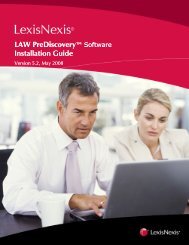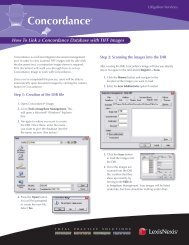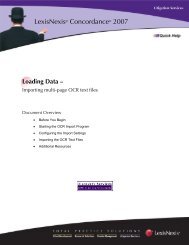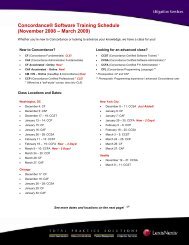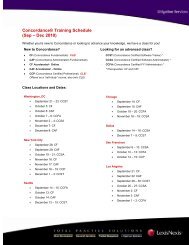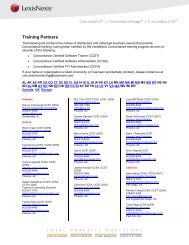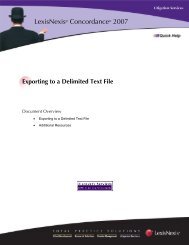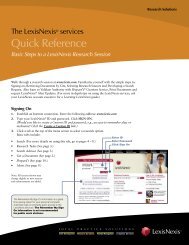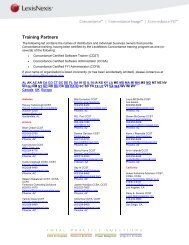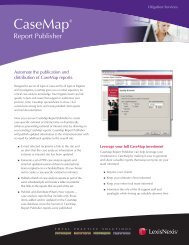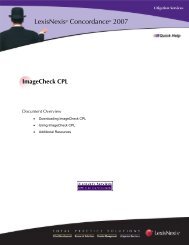LexisNexis Total Practice Advantage 9.0 - Litigation Solutions
LexisNexis Total Practice Advantage 9.0 - Litigation Solutions
LexisNexis Total Practice Advantage 9.0 - Litigation Solutions
Create successful ePaper yourself
Turn your PDF publications into a flip-book with our unique Google optimized e-Paper software.
<strong>LexisNexis</strong> <strong>Total</strong> <strong>Practice</strong> <strong>Advantage</strong> <strong>9.0</strong><br />
4 Enter the SQL Database name. This name must be unique in that no other SQL database can<br />
have the same name. Typically the default of “TimeMatters9” is used.<br />
The database name is used by SQL to refer to the database. If you plan to have multiple SQL<br />
databases, you will want to use names that will help you distinguish the various databases.<br />
The Tutor database is a set of sample data that can be used for training or testing purposes.<br />
This data is stored separately from your actual data. Important data should never be entered<br />
into the Tutor database.<br />
5 Specify a Login ID and Password for the SQL Database. Click Next.<br />
This Login will be added to your list of SQL Login Accounts. This Login will be used by the<br />
Client application as it accesses the SQL database, regardless of workstation or user. Usually<br />
the users will not, and should not, know this SQL database Login and/or Password. The user<br />
will not be asked this information when logging into the database.<br />
Note: If you are creating a new SQL user, the password you enter must meet SQL 2005<br />
password strength requirements. If it does not, you are prompted to enter a different password.<br />
<strong>LexisNexis</strong> <strong>Total</strong> <strong>Practice</strong> <strong>Advantage</strong> performs this check whether or not the check is enabled<br />
in SQL 2005.<br />
This SQL Database Login will have what Microsoft calls “dbowner access” to the SQL<br />
database. This means that a user logging in directly to this database through SQL’s<br />
Administrative applications, with this Login ID and Password, will be able to perform many<br />
tasks, even delete the entire database. You can set up other SQL Login IDs and Passwords in<br />
SQL if you want to give users direct access to the SQL database with particular rights for<br />
special queries or reports.<br />
Each application user will be assigned a unique Login and Password within the Client<br />
application with their own security rights, which will control their actions within the SQL<br />
database.<br />
6 Review the initialization selections made to this point. These selections will be applied by the<br />
install when the Next button is clicked. A screen will display the SQL server and SQL system<br />
administrator information, as well as the information that will be used to generate a new SQL<br />
database. Click Next.<br />
7 Wait for the initialization to complete. When it is complete, click Next.<br />
8 Click Finish to close the wizard.<br />
9 The first time you open the application, you are prompted to register the product. Follow the<br />
instructions in Registering The Software on page 16 to complete this process.<br />
Installing the<br />
Software<br />
Installing the<br />
Software<br />
Installing the<br />
Software<br />
Installing the<br />
Software<br />
Installing the<br />
Software<br />
Creating & Initializing the SQL Database 15



